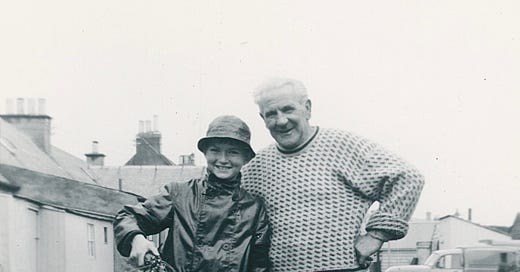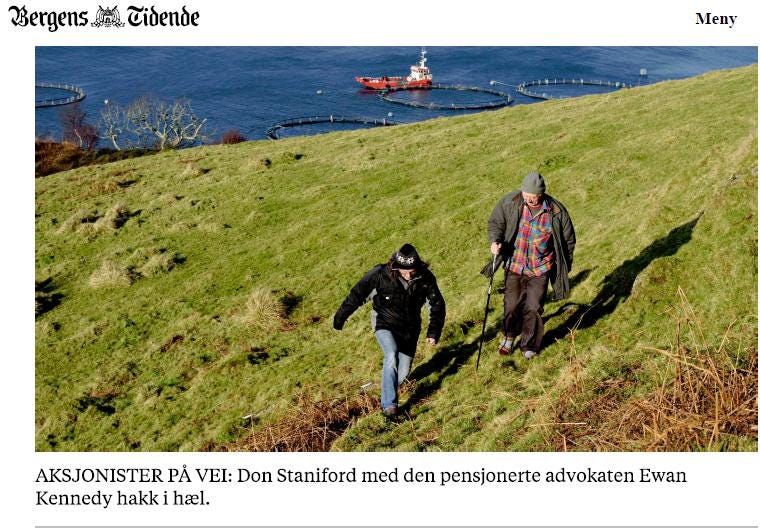The writer and Real Jake, at St Abbs in the mid 1950s
Alongside a lifetime working in the law, I’ve had an interest in the sea and our coastal waters since my earliest days, thanks to family holidays in the fishing village of St Abbs. My brother and I were sent out creeling with a famous Berwickshire personality, Jake Nisbet, known locally as the Real Jake, a survivor of Salvesens whalers and the Russian convoys, for which he’d been awarded the British Empire Medal. A charismatic fellow, Jake was responsible for introducing many holiday children to the coastal environment. Decades later, when I was in contact with the late wild salmon man Bruce Sandison, I discovered that he had also been one of Jake’s apprentices; I suspect that Jake instilled in all of us not only a sense of how dangerous the sea can be, but how important it is to look after our environment.
The lesson stayed with me, and I have watched with horror the relentless expansion of salmon farming on our west coast. For over fifty years, I’ve spent time exploring the inshore waters of Argyll, from first renting a mooring for a small open boat in Oban Bay in 1974, to decades sailing an old Scottish Islander with a cabin, to my present little cruising boat, designed for single handed sailing. During that period I’ve seen fish farms growing in numbers and in size, from just a few cages holding perhaps 100 tonnes of biomass, to the present day, when 2,500 tonnes is quite common, and in some areas a farm in every sheltered bay. Right now there are proposals in the pipeline for units up to 8,000 tonnes. At four to five kilograms per mature salmon that works out at 200/250 fish per tonne, and a total caged population of between 1.6 and 2.00 million per farm. The total quantity of excrement flowing out into the water column far exceeds the sewage from quite substantial coastal towns such as Oban. One does not need to be a graduate in marine biology to see that this must seriously unbalance the natural environment. Divers have reported that the seabed under long standing farms is effectively dead, suffocated by piles of faeces and uneaten fish food
The east coast is exempt, thanks to the secret deal between the industry organisation and the then Scottish Executive, revealed in a BBC interview in 2001 between Lesley Riddoch and Brian Simpson, CEO of Lord Lindsay’s trade body Scottish Quality Salmon, that was exposed by the aforesaid Bruce Sandison. The financial value of Scotland’s big salmon rivers, the Dee, the Spey, the Tay, and the Tweed was just too important to put at risk. If you doubt me, just google how much it costs to rent a stretch or to buy a timeshare for a week’s fishing!
From time to time I got involved in litigations around salmon farms. One of the earliest concerned an oyster farm that was destroyed by the use of the deadly TBT antifouling on the cages of a nearby salmon unit. The idea of allowing one of the deadliest poisons around anywhere near food production still gives me a shiver! The ruined oyster farm ended in an out of court settlement, based on the law of good neighbourhood. Scots lawyers love old Latin maxims, and the principle sic utere tuam alterum non laedas, use your property in such a way as not to damage that of your neighbour, applied.
The long forgotten Tripartite Working Group
By the early 2000s the Scottish Executive were becoming worried about fish farms being placed in locations that suited companies, but were often highly damaging, as a result of deals done with Crown Estate Scotland. They set up a “Tripartite Working Group” comprising representatives of government, the fish farming industry and wild fishery interests to review the environmental problems caused by fish farming and make recommendations.
The group advised that many fish farms, granted without planning consent, or any environmental assessments, were in the wrong place and recommended running a “Pilot Relocation Project” in terms of which the taxpayer would sponsor companies to move from damaging sites to ones considered less so. Three sites were chosen, but only one ever went ahead. This involved shifting production from Loch Riddon to Ardmaddy, near where I live.
Loch Riddon was chosen because the Fisheries Board, anglers and locals were reporting serious declines in catches on the River Ruel and attributing the problems to chemical treatments and sea lice from the local fish farm, operated by Pan Fish. This had had a direct economic effect on the local economy and several hotels had closed.
It seems that Ardmaddy was chosen for two reasons. First, Pan Fish already operated a salmon farm there with a permitted capacity of 800 tonnes, which made things easier administratively. Second, locals there were then totally unaware of the issues. Presumably the less we knew the less fuss there would be.
On 8 April 2008 the Ministerial Working Group on Aquaculture put out a press statement stating that the project was under way, not naming Ardmaddy, with State aid approved by the European Commission. The cost to the taxpayer was £370,000. There was promised in due course a “lessons learned report”, but it never arrived and the group no longer exists. History has now written the report, but the lessons haven’t been learned.
I’ll spare you all the details of what happened at Ardmaddy. The planning application to increase the capacity to 1300 tonnes went ahead practically unnoticed in the community, as was no doubt hoped for, and was signed off by Argyll & Bute’s planning officers under delegated powers.
As always the application was based on SEPA’s Autodepomod computer modelling, which produced results which turned out to be totally wrong, so the site could no longer be operated. Instead of being closed down, the company proposed to move to another site further south, again based on SEPA’s defective modelling system.
This time the locals had woken up to what was going on. The application attracted 814 objections, including over a quarter of the adult population of Seil, Easdale and Luing. Only one resident wrote in support.
What followed was a good chance to see democracy in action, Argyll style, when the planning committee were unanimous in granting the application. The issue came down to arguments about jobs – preserving employment in the operating company and its suppliers versus the threat perceived by the local residents to their own jobs in tourism and leisure based businesses.
Once again, experience on site proved what local residents, including marine biologists, operators of wild life tours and creel fishers, had stated in their numerous objections, that tidal conditions made the site untenable. After periods during which the site lay unstocked it was eventually surrendered. Nobody had got a job out of it.
In the final days of Ardmaddy, an activity described as smalloping over the terrain.
But that wasn’t the end. In exchange for MOWI giving it up, Argyll & Bute Council granted them planning consent for massive expansions of capacity at other two farms, Pol na Gille and Baigh Dail nan Ceann, to a total of 6000 tonnes, way over the limits permitted in terms of the then current regulations for control of pollution. To summarise, get consent based on computer modelling, try it out and if it doesn't work, trade it in for something really worthwhile, that you wouldn’t normally have obtained.
It’s extremely disturbing that the lessons from Loch Riddon have been forgotten and we now see applications in even more unsuitable places, exemplified by a current one at Loch Long. Of all our west coast sea lochs, I can’t imagine one less suited to fish farming than Loch Long, long, narrow and a huge distance from open sea. With tidal flows on the west coast generally from south to north, it must take decades for the water column to be totally renewed.
Loch Long Salmon say that if their experimental installation doesn’t work, they’ll remove it (where’s the Precautionary Principle when you need it?). Well, we saw that at Ardmaddy. Planning once granted is for a site, not a process. It becomes an asset that, while it can’t literally be sold, can be exploited in countless other ways.
As I write this, the decision over the Loch Long unit has been with the Scottish Government’s Reporter for many months. Meanwhile, the same company is threatening the locals in Loch Linnhe with a similar gigantic unit, containing 8,000 tonnes.
Scotland’s environment is our most precious national asset, and our extensive seas are a major part of that. The seabed is held by Crown Estate Scotland in trust for all of us, and they are breaching that trust by allowing foreign multinationals, mainly owned by Norwegian, Icelandic and Faroese governments and investors, to use it with an almost total lack of effective control. For some inexplicable reason, Scottish Government ministers are also complicit, and have convinced themselves that allowing it to be irreparably damaged, for the sake of a paltry number of jobs along a coastline already suffering from a lack of young workers and a housing shortage.
In future articles I’ll be diving more deeply into these murky waters!
On a rather nicer subject, if you’re interested in the west coast, or sailing, or just some stories about lovely old boats and the folk who sailed them, my book on The Scottish Islanders is available from the publishers at www.shop.yachtarchive.scot




